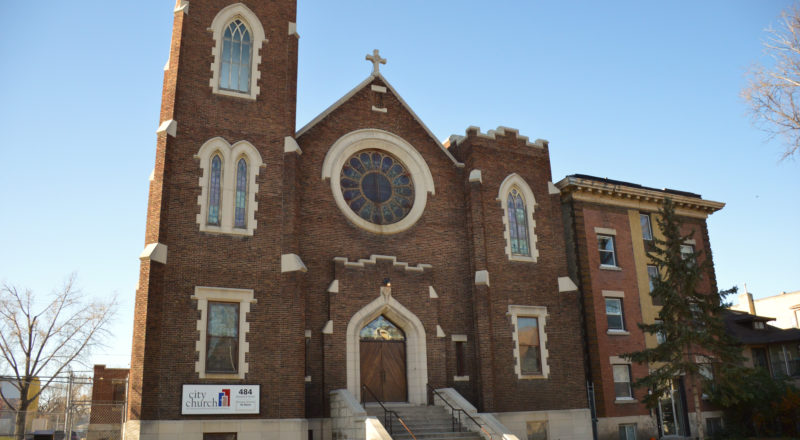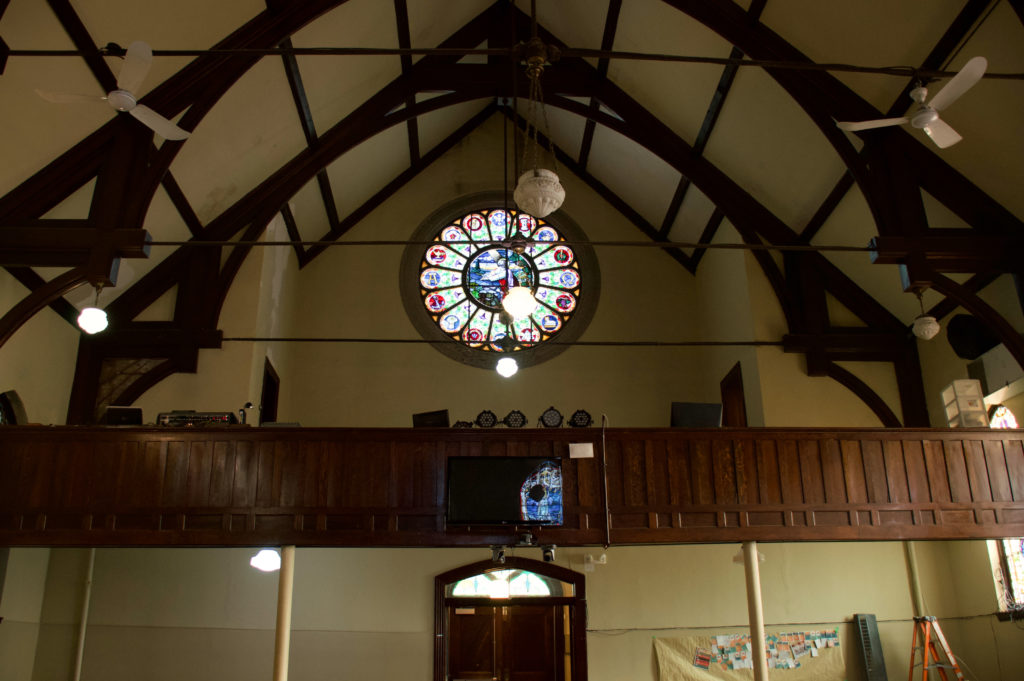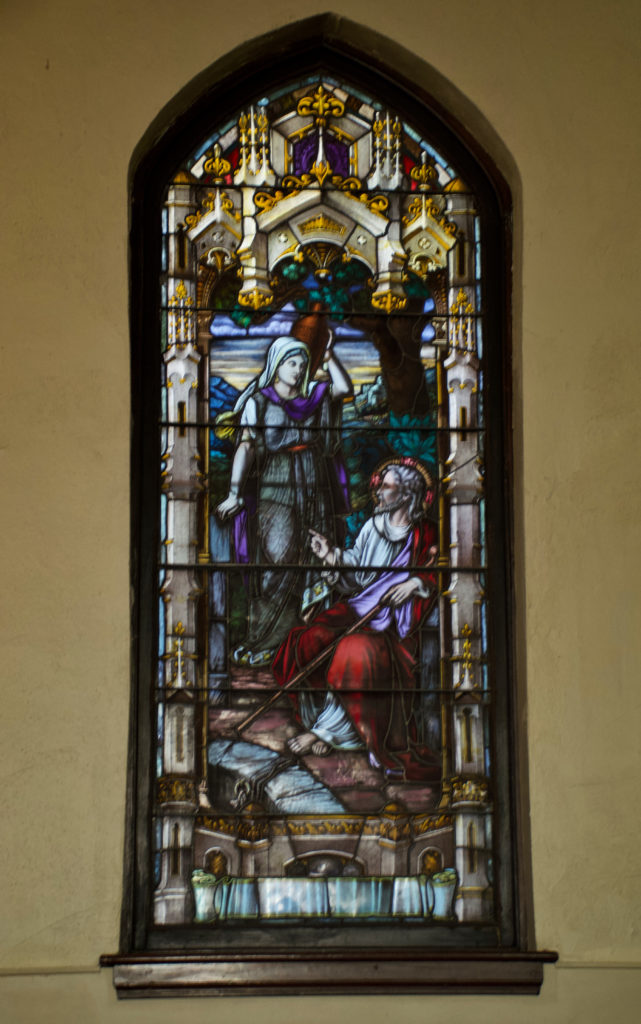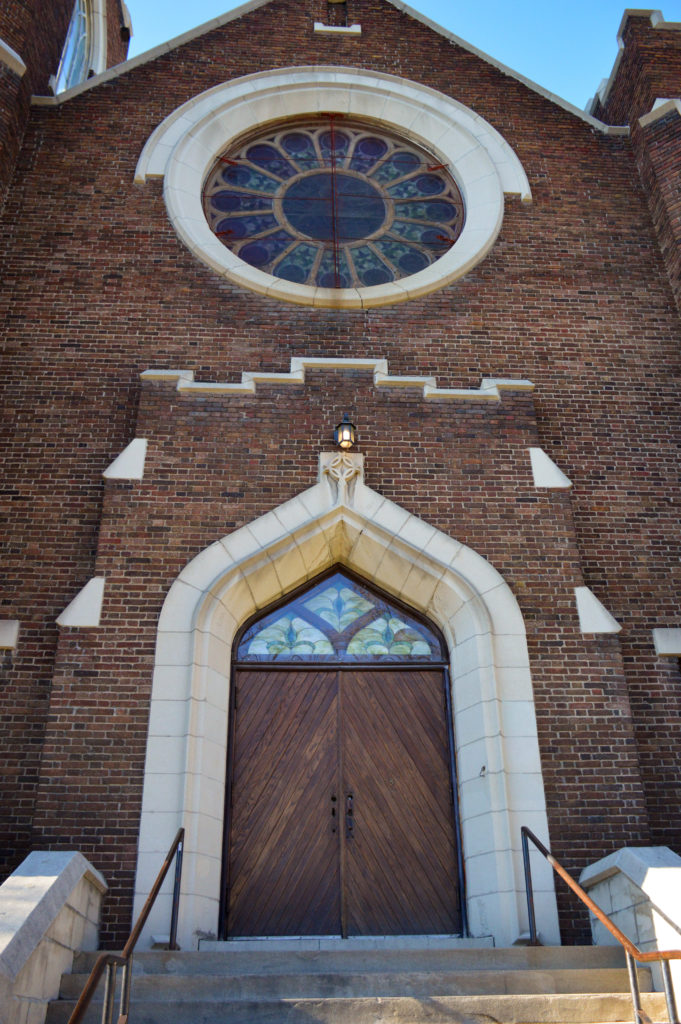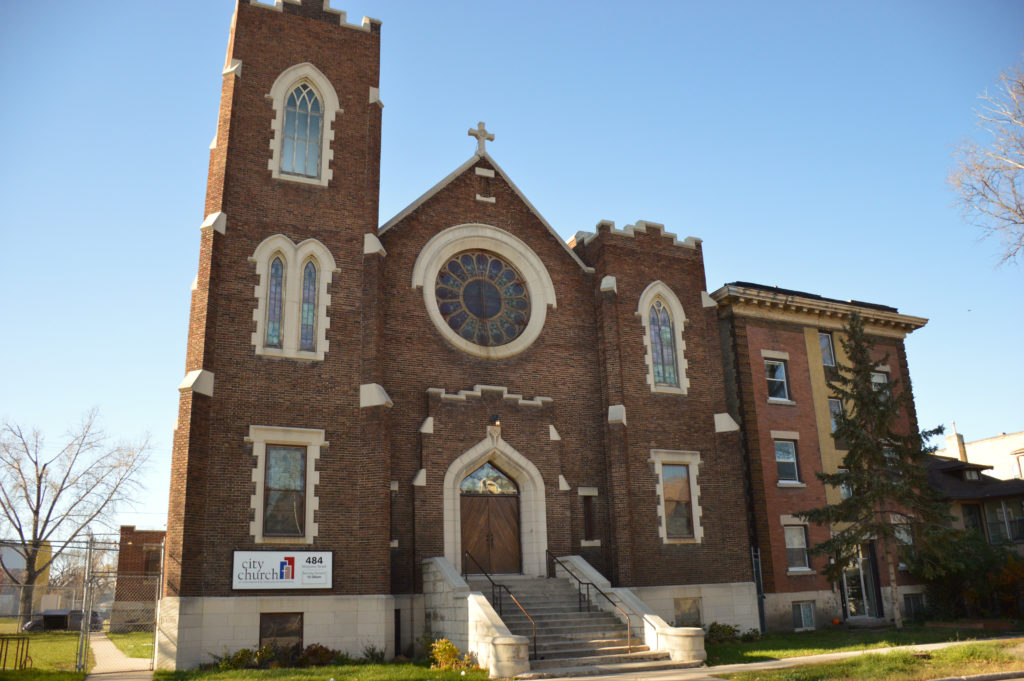
/ Blog
January 6, 2022
Breaking Ground in Winnipeg’s West End: The First English Lutheran Church
Located in Winnipeg’s West End at 484 Maryland Street, is the First English Lutheran Church building, now known as City Church. Immediately upon arriving, one is struck by the building’s Gothic architecture and the large, beautiful stained glass rose window welcoming you above the front entrance. The building’s exterior is impressive, however, what is equally impressive is the history of the building’s inhabitance. Upon research, this building’s history reveals an evolution in Winnipeg’s religious communities. Not only did this Church foster the first-ever all English-speaking Lutheran congregation, but has more recently become a site of intercultural worship, reflecting and representing the diverse world we live in today.
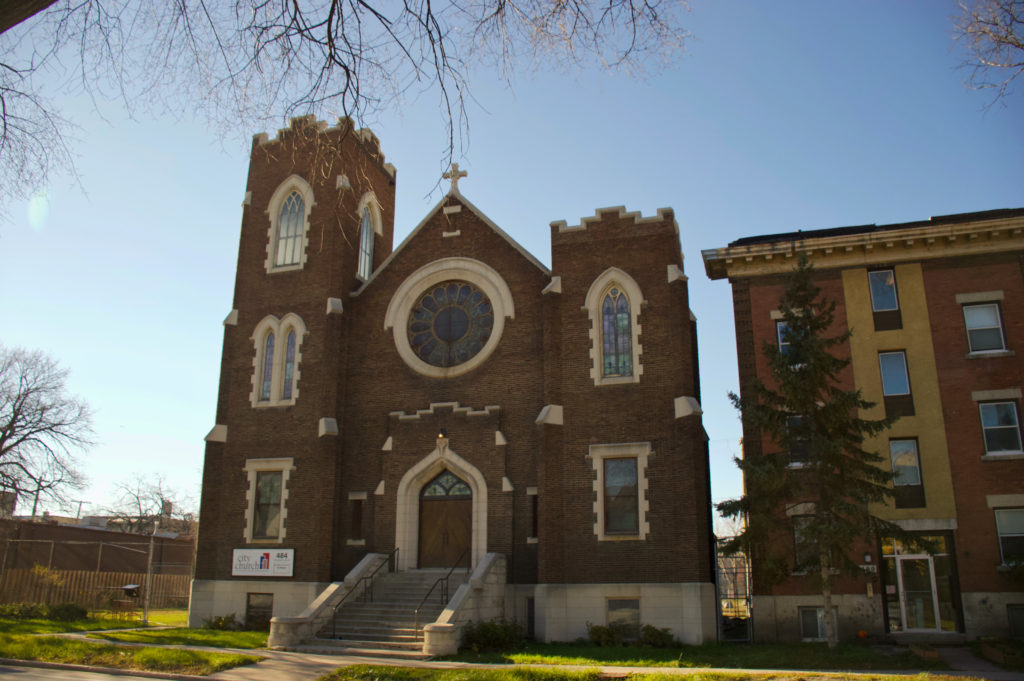
The front facade of the First English Lutheran Church at 484 Maryland Street, now known as City Church.
Source: Heritage Winnipeg
The story of 484 Maryland begins at the start of the 20th century with a mere idea. During this time, the Lutheran community in Winnipeg was predominately made up of northern European immigrants. As a result, all of the city’s Lutheran services were performed in languages such as Norwegian and Swedish. This created a need for English language Lutheran services for the growing number of second-generation Canadians and other English-speaking Canadians who wanted to worship in a Lutheran church. In recognizing this concern, a small group of English Lutherans met in front of the British Foreign Bible Society offices to discuss the organization of a new congregation. Amongst the group were three newspaper editors who had been invited to publicize the formation of the English Lutheran congregation. By June of 1905, the first all English-speaking Lutheran service commenced. With that said, the congregation did not have a proper building to meet in, so the service was held outside in a tent on the corner of Ellice Avenue and Beverley Street. It was at that first service that 28 people signed the charter formalizing the organization of First English Lutheran Church.
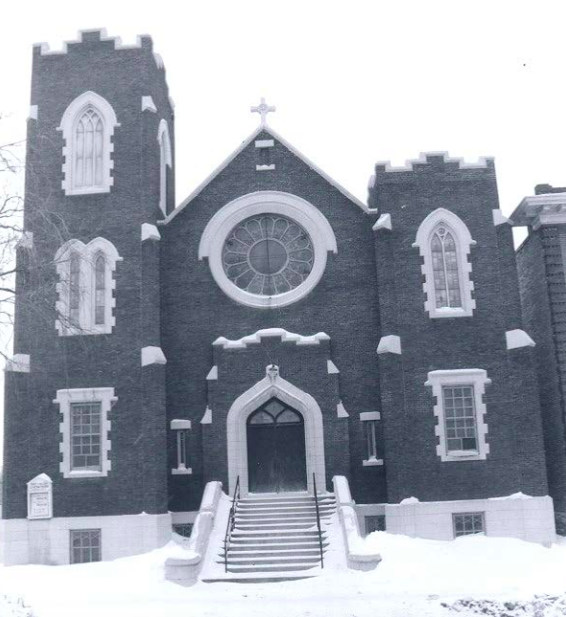
The First English Lutheran Church in 1978.
Source: City of Winnipeg Report
From June to October of 1905, the First English congregation would meet at this tent, continuing to hold open-air services. It was not until a large storm hit, damaging the congregation’s tent, that First English would purchase the corner property at Ellice Avenue and Beverley Street for the construction of a permanent building. The construction of a one-room church on the property was completed in January 1906. From its initial organization in 1905, the First English Lutheran Church’s membership continued to increase and the congregation quickly outgrew its one-room church. In 1910, First English purchased property at 484 Maryland Street to construct the church that is currently standing today.
Construction of the Maryland Street church began in 1911 with the basement. The whole project took until 1913 to be completed, with contracting firm Bruce and Bostrom and architect Ralph L. Smith. Smith is relatively unknown in the history of Winnipeg’s architecture. He was born in the United States in 1874 and came to Canada in 1907. During his time in Winnipeg, Smith primarily specialized in designing school buildings, along with a handful of churches. It is believed that Smith left Winnipeg sometime after 1914 since his name only appears in the City of Winnipeg Permit Ledger four times between the years of 1899-1926. This would also explain why his architectural work within the city is limited. One of Smith’s more notable designs in the city includes the First Lutheran Church at 580 Victor Street (1912) in addition to the First English Lutheran Church on Maryland Street (1913).
The exterior of the 484 Maryland Street church stands out from its residential neighbours. The church’s architecture is not only grand in scale, but it is an excellent example of Gothic Revival style. Gothic Revival is an architectural style that draws inspiration from medieval architecture. Its most identifiable features include pointed arches used for windows, doors, and other decorative elements, as well as castle-like towers and detailed woodwork. In Winnipeg, many Anglican, Baptist, and Lutheran churches built around the time of First English exhibit similar gothic elements however, the First English Lutheran Church is one of the city’s finest examples. In both the building’s exterior and interior, Gothic Revival elements are recognized in the church’s Gothic arch details, the tower that stands to the left of the main entrance, as well as the interior’s rib vault ceiling. The dark brick exterior is set upon a limestone foundation, with smooth, cut limestone framing the windows.

Looking towards the altar inside the First English Lutheran Church in 2021.
Source: Heritage Winnipeg
In addition to the church’s Gothic architectural style, what also makes the Maryland Street building stand out is its impressive collection of stained-glass windows. Designed and produced by the Luxfer Prism Company in Toronto, each window was made and installed in 1913 as part of the initial church construction. The inscriptions found in the scrolls at the foot of the tall, rectangular windows in the main body of the church were all added in later years. Every window shares a different story with the images that they contain. Furthermore, all the windows contain bright and colourful designs that help the glass stand out from the rest of the church’s interior and exterior design.
On November 30th, 1913, the English Lutheran Church opened its doors on Maryland Street to its congregation for the first time. The new church contained a larger congregation space at its heart, with a second-floor balcony, a basement, and adjoining rooms off the main space to accommodate the ever-growing Lutheran congregation. Additionally, the building also attracted new members, as it could now support a much larger audience with its accommodations. Being Winnipeg’s first all English-speaking Lutheran church, First English has had a long history of pushing the boundaries of religious meetings from its creation. For example, from September to November in 1914, First English forbid any discussion of the war among its congregation at church. This, unsurprisingly, stirred up conflict as many members and their loved ones were either soldiers themselves or knew someone who was overseas. As a result, many members withdrew from the church. Forbidding the discussion of war during this time was controversial, however, First English did manage to gain 38 new members from this decision.
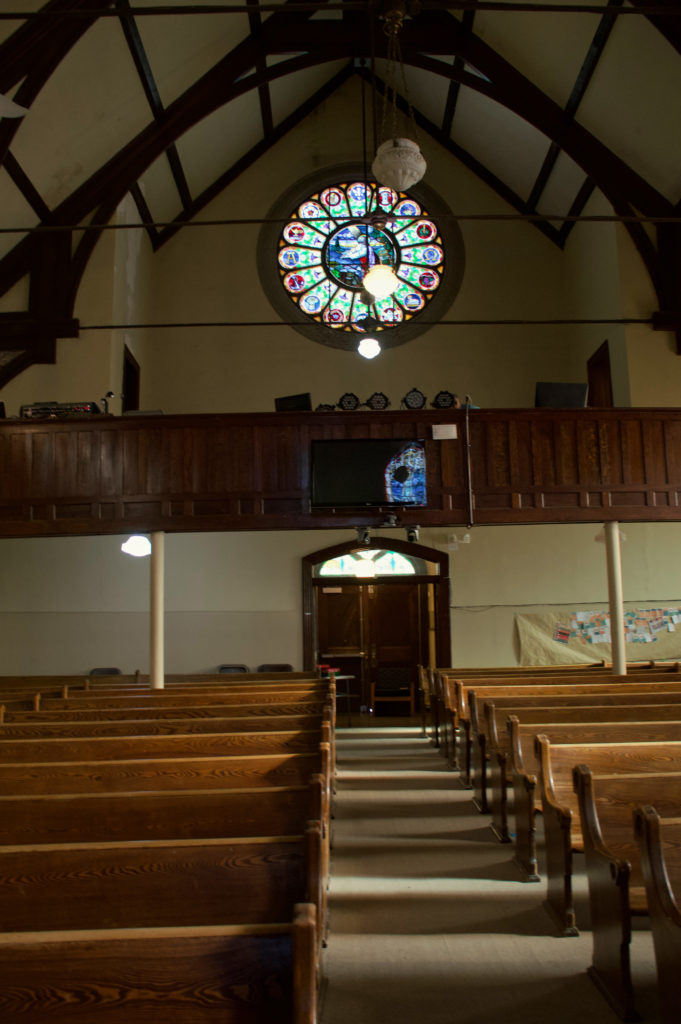
Looking down the aisle towards the front entrance inside the First English Lutheran Church in 2021.
Source: Heritage Winnipeg
In the 1960s, First English became the site of a counseling radio program, Ask the Pastor. Hosted by Reverend Egler who served at the church for 25 years, Ask the Pastor aired on Sunday nights from 11:30 pm to 1:00 am. In response to the growing popularity of audience participatory radio shows, Ask the Pastor was a confessional show where listeners could phone in and ask Egler for religious or non-religious advice. This was very unconventional for a church, however, it did show how a traditional establishment could adapt to cater to the ever-changing communication of the world. Moreover, hosting a radio show also allowed First English to reach a much larger and broader audience than ever before.
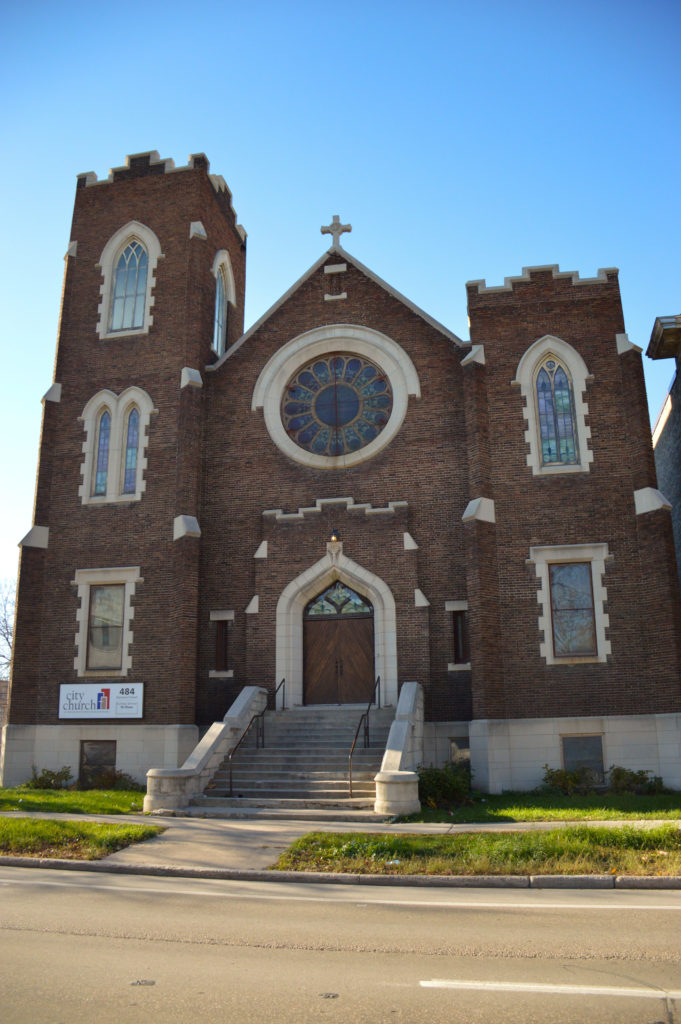
The front facade of the First English Lutheran Church in 2021, with its beautiful stained glass windows.
Source: Heritage Winnipeg
First English served in Winnipeg for nearly 100 years, until 2005 when the church’s congregation became too small to keep up with the large Maryland Street building. Over its years in service, First English was innovative in its ways of interacting with its community. From the radio show to opening up a thrift store in its basement in 1988 to sponsoring refugees in the 1990s, First English’s ability to adapt to modern-day was inspiring. During its peak, First English would attract nearly 800-1000 people a month. However, in the years following the introduction of other English-speaking Lutheran churches, First English’s membership steadily declined as the novelty of 484 Maryland wore off. As a result, First English agreed to amalgamate its congregation with Our Saviours Lutheran Church. All members and records were transferred to Our Saviours, where they continue to be held today and the Maryland Street church location was vacated.
In the years following First English’s congregation’s move to Our Saviours, the Maryland Street building rotated between a few projects. From a judo studio to a failed developer’s attempt to adaptively reuse the church as condos, nothing seemed to stick around for long. It was not until 2008 that the First English Lutheran Church had new life breathed into it. Purchased by Grant Memorial Baptist Church, 484 Maryland Street reopened as City Church. City Church was created as an intercultural and multicultural congregation to foster the large immigrant and refugee community that makes up the West End. The congregation primarily comes from the radius neighbourhoods of Portage Avenue, Notre Dame Avenue, Arlington Street, and Hargrave Street, all of which are heavily populated with newcomers to Winnipeg. Around 30% of residents in City Church’s neighbourhood are visible minorities, making the need for a multicultural community meeting place a natural development.
Under the leadership of Tim Nielsen and Indiana Cungcin, City Church prides itself on creating a church environment that allows friendships and connections to flourish out of diversity and difference rather than similarities. The congregation is made up of people from all over the world, including Eritrea, Burundi, Rwanda, Kenya, Cameroon, Somalia, and Sudan, just to name a few. There are also people from multiple ethnic groups within Burma and some Indigenous attendants. Like First English, City Church’s services are given in English, however, Pastor Nielsen’s sermons are also translated and projected into various languages on a screen hanging just to the left of the centre. One can also find translators present at Sunday services, giving in-person translations in either Chin or Karen, which are languages of the two cultural groups of Burma that are significantly present at City Church. Additionally, Swahili and French translations can also be heard for members from various African countries.

Looking down from the balcony of the First English Lutheran Church in 2021.
Source: Heritage Winnipeg
In 2017 City Church expanded its presence and opened Naomi House. Located on 700 Ellice Avenue, Naomi House is a seven-bedroom transitional house for newly arriving refugees and asylum seekers. In addition to providing a transitional house, Naomi House also houses City Church’s City Connexions (CCx) ministry as well as the church offices. The CCx ministry helps newcomers’ transition to Winnipeg by providing programs that will help refugees and others with employment opportunities. In 2020, Naomi House joined the Sponsorship Agreement Holders (SAH) program. Created by the federal government, the SAH program helps resettle refugees in Canada and provides services, resources, and support.
City Church shares an important history with First English, being that both congregations were ground-breaking and innovative in their own right. For First English, it was providing Winnipeg’s English-speaking Lutheran community a place to worship, as well as including new and interesting ways to engage with its community through amenities like Ask the Pastor and opening a thrift store. Similarly, for City Church, the congregation redefined what a religious community looks and sounds like by creating an intercultural organization that provides for everyone. When speaking to Pastor Tim Nielsen, it is clear that the sense of community and togetherness runs throughout the church. The welcoming nature of City Church fosters a strong and tight-knit community that supports one another. City Church proves that coming together over a common belief can not only bring a diverse community together but can break down boundaries that separate people in society today. It is wonderful to see this historic church continuing its invaluable work as a leader in welcoming and fostering a community for over 100 years!
Special thanks to City Church pastor Tim Nielsen who graciously let Heritage Winnipeg come visit City Church and provided us with invaluable insight into the building’s history. This blog post would not have been possible without his contributions!
THANK YOU TO THE SPONSOR OF THIS BLOG POST:

Written by Heritage Winnipeg.
SOURCES:
484 Maryland Street Summary Report, City of Winnipeg
Manitoba Historical Society, First English Lutheran Church/City Church
Manitoba Historical Society, Ralph L. Smith
Pennsylvania Historical & Museum Commission, Gothic Revival Style 1830-1860
Alice Hamilton, Manitoban Stained Glass, The University of Winnipeg Press, 1970.
Alana Trachenko, “A Home for Refugees in the West End,” Winnipeg Free Press. September 28, 2015.
The First English Story, 1905-1995, provided by Tim Nielsen
First English Lutheran Closing Service, 2005, provided by Tim Nielsen





